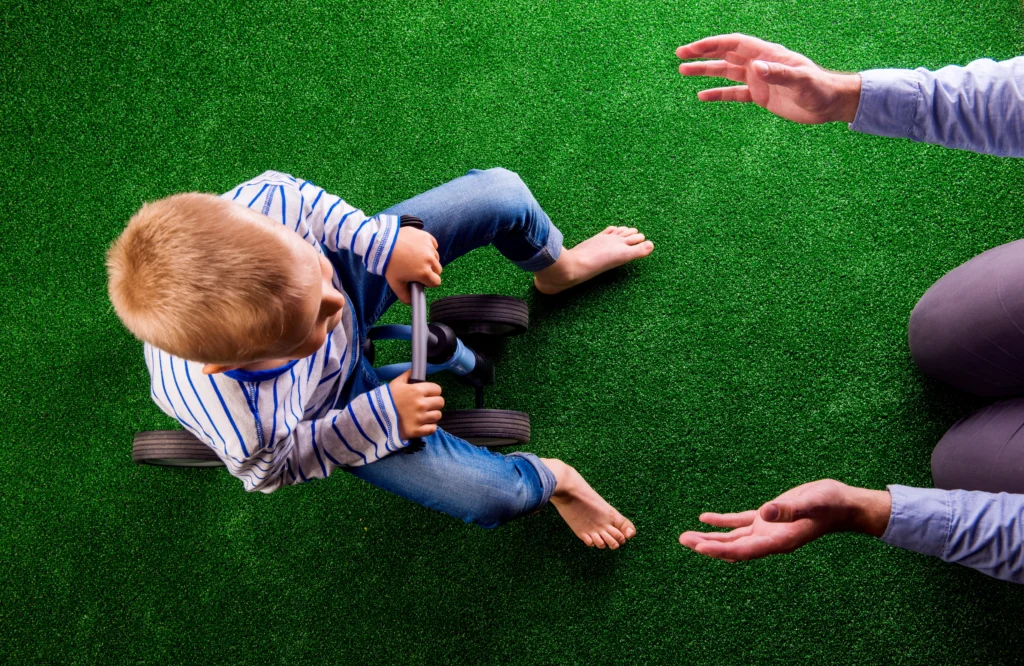Exploring the shift from automatic responses to mindful choices in parenting.

Parenting is more of an autopilot process. A child is crying and we re-play it and sometimes we are frustrated and sometimes we are in authority. There is an opportunity for connection in this trend. In the current times we have a number of families who are learning to stop, think and act. It is the process of desensitising to automatic responses and substituting it with conscious one to which turns out to be the basis of conscious parenting whose basis lies in the capacity of being aware of emotions, being empathetic, and having control over them. What Is Conscious Parenting? Conscious parenting may be explained as a method of child rearing in a conscious and emotional manner. It requests parents to be aware of what arouses them and communicate directly and deliberately instead of impulsively. It is also based on respect, growth and emotional security as opposed to obedience which is the element in the traditional practices. The style tends to be identical to the Attachment parenting practices and respectful parenting that is founded on the principles of trust and empathy without punishment. In a way, it improves the development of the relationship between the parents and the kids who are considered to be heard and appreciated. Why Mindful Choices Matter Children will know by the way we manage feelings and not what we say. The conscious choice will assist in turning the day-to-day challenges that tantrums, defiance, and emotional outbursts into the lessons and time of connection. Major Strengths Forms closer emotional attachment through Co-regulation Parenting where the children are allowed to relax as they are given by the parent the sense of stability. When parents are reactive instead of reflective they are instilling emotional intelligence in themselves as a lifetime competence that would play a role in making relationships healthier. Finding Conscious Parenting at Home. A person must take time and learn how to implement conscious parenting techniques at home. The points of starting are the following: This also connects to Gentle parenting methods for dealing with tantrums, where empathy and calm communication replace punishment. Favourable blocks to Mindful and Conscious parenting. Previous behaviours are so backward with ease when sensitised. Automatic eliciting responses are stress, fatigue or pressure of time. It is also the fear of parents that one is soft and therefore, he is lenient. The thing is that soft parenting styles of tantrums settlements are strict and not violent. Borders and pity will not be a danger to authority, but it will develop trust. It is also possible to achieve Parenting Workshops or therapy groups to help the parents re-learn the inherited styles of parenting and can identify the sources of the peaceful communication. It is assumed that these spaces are thought-provoking that allows parents to control their emotions right away. Conclusion The evolutionary process of the eradication of automatic responses to conscious choice is gradual. It must only be patient, kind, not good. Families will be able to establish understanding based and trust based homes when they experience active conscious co-parenting and active emotional involvement. With parents being conscious of their actions, the children grow to be emotionally strong even beyond their childhood and their emotional strength is modelled similarly. Visit Vedandi Brahambhatt on Instagram and YouTube to read daily posts, tips on mindful parenthood and professional advice on how to bring up an emotionally balanced child. FAQs Why then is there conscious parenting?It will include establishing a reciprocity and affectionate attachment between parent and child through mindful or conscious and unconscious reaction. What is the place of co-regulation in the context of tantrums?It makes the children feel safe since the parent is relaxed in his/her body language and the tone of the voice that reduces stress and emotional learning. Is conscious parenting effective with children of later age?Yes. The mindfulness in communication and emotional boundaries come in quite handy to the adolescents, but the style can be introduced at a later stage. Do the parenting workshops work with the beginners?Absolutely. They provide directions, the assistance, which is essential and rehearsal helpful in practising conscious parenting.So now what is the beginning of mindful parenting?The first step is to be self-conscious, learn to become aware of what causes you and count to one breath before responding and remind yourself of the fact that you can be stronger than being in control.
Explaining the neuroscience of attachment and how everyday presence rewires the brain.

The human brain is interrelated and therefore in early childhood. Every look, every word, every touch on part of a parent establishes the neural patterns of emotional intelligence and trust. Neuroscience has proven that the regular affectionate availability can even physically change the brain of a child to respond to stress, safety and relationships. This makes attachment not only an emotional concept, but a biological concept that lies in the core of the Holistic Child Development. Knowledge of Attachment With Neuroscience. The emotional linkage that forms between the child and its parent is referred to as attachment and arises as an outcome of day to day attention and empathy. When a child is calm, secure, and open, then the brain will generate serotonin and oxytocin which are the chemicals linked to serenity and joy. It is a supportive family environment that ensures that the limbic system which is the emotional and balancing of the child develops in stability and not in fear. Conversely, the unpredictable care activates processes of stress, which the brain learns to be awake rather than being in a relaxed state. This is the reason the presence in daily life is more important than each of the parenting acts. Children and EI: The Reason to Be Emotionally Intelligent. The process through which a child develops emotional intelligence in child development begins when the children see how their caregivers are handling emotions. Parents also display the skill to name and manage emotions by not responding reactively to their children. The more the parent thinks as the child does and ascertains it, the more are the neural pathways strengthened in the sphere of caring and self-awareness. This is a resilience formation of these minor and repetitive experiences. Emotional learning cannot be taught in the lessons, but experiences of lived interactions is the opportunity to receive and understand feelings. Empathy, Respect and Compassion in Parenting. Respectful parenting and Empathy and Compassion Parenting focus on the interpretation of the feeling that a child acts in the manner and do not punish them immediately. This will help the child to feel instead of being judged. Individual parents who act in a manner that makes use of empathy inculcate the same to kids. This helps in building empathy and compassion in young children resulting in creating emotional stability and greater sensitivity to the society. Difficult Times of Parenting Unconditional Love. True growth is made in difficult circumstances. Unconditional Love Parenting means that you have to be emotional even when you are frustrated with the child. This is what neuroscience demonstrates and helps in managing the amygdala of the child, which is the centre of the brain of fear, so that the child becomes less fearful and more trusting. The Practicing unconditional love in challenging parenting situations can include the unconditional love shown by the parents in the challenging situations of parenting by: This type of behaviour informs the brain of the child: love is not withheld in a time of stress. This, with time, reinstates emotional memory which is a lesson in security and not fear. Family Relationship and Day to Day Companionship. Small repetitive gestures of existence are beyond perfection. Activity in a group like meals, reading or a weekly Family Meeting helps children develop association of being attached with being safe. It is the mirror neurons of the brain that are involved in these instances and that the parent-child emotions are aligned. Teamwork and knowledge is generated through this spirit of togetherness. The formation of long-term wellbeing is built at the level of families that make a conscious slowdown and devote time to each other that forms the neural conditions. Trust happens to be the design of presence. Conclusion Attachment is not an event it is the science of day-to-day connection. Parents not only influence the emotional level but the brain also organises itself with the help of empathy, respect, and Unconditional Love Parenting. The process of developing the child holistically involves minute gestures of consistent love in order to establish neural interconnections and emotional security. Having that, parents do not just create a child, they create that child brain to learn to love, to trust and prosper as well. Visit Vedandi Brahambhatt on Instagram and YouTube to read daily posts, tips on mindful parenthood and professional advice on how to bring up an emotionally balanced child. FAQs What is the neuroscience behind attachment?The trust and the emotional intelligence in child development of the early childhood is enhanced because the parts of the brain involved in safety and regulation are triggered by the attachments. How does the presence affect the development process of a child?Connexion also assists in the construction of neural networks that govern emotions and the level of stress and improves wellbeing over the long run. What do we mean under respectful parenting?It is an approach technique that entails compassion, communication, and comprehension in a bid to make children feel that they are treasured and secure. How can children in families be empathised?In order to express empathy, involve in collective activities, listen and encourage open communication during Family Meeting and family interaction.Is unconditional parenting love relevant?Even during the conflict, stable love reforms the brain to enable it to adjust to the strength and trains children on the idea of being emotionally stable through Unconditional Love Parenting.
How to Foster a Growth Mindset in Children

It takes more than imparting facts and skills as a parent, it is about raising how children think about things, learning, and themselves. The habit of cultivating a growth mindset among children, the sense that skills are developable through practice and education, prepares resiliency, curiosity, and lifetime achievement. To parents, and particularly to mindful parents, this attitude is a powerful gift that can influence even toddlerhood activities down to schooling and relationships. Vedangi Brahmbhatt, who is a professional development expert in child development, assists families in the USA to raise conscious and nurturing homes in which children can develop holistically. Find below practical ways of promoting a growth mindset within your family. 1. Encourage Effort Over Outcome Being willing to appreciate effort over short-term success is one foundation of a growth mindset. Rather than applauding only results such as good grades or trophies, encourage the process itself- hard work, persistence and problem solving. Provide positive reinforcement when a toddler is engaged in an activity or performing homework. Compliment things such as, I can see that you are trying so much, or It is alright to get it wrong, that is how we learn. Such a change in language makes the children realize that learning is a process rather than a product. 2. Model Resilience and Emotional Regulation Children learn through observing their parents. When you overcome obstacles in a cool and patient manner, you demonstrate key skills in life. Emotional regulation that kids require practicing entails remaining realistic in times of family tragedies and personalizing feelings by employing resources such as nonviolent communication. Beneficial elements such as family meetings in which everyone talks about the positive things accomplished, challenges, and plans can also help build resilience and connectedness. This is also an active listening parenting model, and every family member would feel appreciated and understood. 3. Create a Holistic Environment for Learning and Growth Nurturing the environment not only aids intellectual development but also emotional and social development- the tenets of holistic child development are considered. The motivation is created by designing challenging activities for toddlers that build the skills gently and at the same time encourage creativity. Also, the adoption of positive strategies of discipline on toddlers to instill autonomy and self-control will remind the child that hard work results in development. Parents can be provided with effective methods of maintaining this positive environment by investing in the best parenting books and learning how they could apply the conscious parenting methods in their homes. Conclusion: Inspire Lifelong Growth with Mindful Parenting Nurturing the growth mentality will enable the children to take risks, learn to make mistakes, and live well as curious people. It is through conscious parenting styles adopted by parents that foster such attributes as they build strong and sensitive family relationships. To have individual assistance on child development guidance, explore Vedangi Brahmbhatt consultations, classes, and resources that are offered to conscious parents. Don’t forget to subscribe to us on Instagram, and YouTube to learn more about parenting and get inspired. Daily Tip: Find joy in little things and think about what has been learnt instead of merely accomplishment. This mere practice strengthens growth mindset thinking. To get in touch for our latest news and press releases, follow this link.Visit vedangibrahmbhatt.com for expert guidance and resources to raise resilient, curious, and confident children. #The Connection Between Mindfulness and Peaceful Parenting.
Raising a Highly Sensitive Child: What You Need to Know

Introduction Rearing a highly sensitive child is a special and fulfilling experience that is accompanied with its pleasures and struggles. Such children have a strong sense of empathy, high level of intuition and heightened sensitivity and therefore they are more sensitive to the environment they are in, but are also prone to overwhelm. Since you are the conscious parent, it is important to be aware of the sensibilities of your child and apply nurturing principles to grow and acquire strength in the fast-paced world. Under the direction of Vedangi Brahmbhatt, an expert child development expert, this blog provides insights to the USA family in need of knowing, supporting, and empowering their highly sensitive child through practical and empathetic tools. 1. Recognize Sensitivity as a Strength, Not a Weakness Highly sensitive children are usually not understood, especially in a place where emotional expression is not appreciated. Such children can be very sensitive to sensory activities (such as loudness or rough clothes), the alteration of routines, or even slight change in the dynamics of the family. Mindful parenting proposes that we embrace these qualities instead of suppressing them. Thanks to proper toddler activities, taking into consideration sensory preferences and emotional comfort (gentle play, quiet time, art, walks in nature), parents can make sensitive kids prosper. 2. Use Nonviolent Communication and Positive Discipline Sensitive children require discipline–not by inflicting severe punishments on them or yelling at them. Nonviolent communication is a technique that is centered on empathy, validation, and direction of behavior using soft boundaries. The positive discipline practices with the toddlers, including the ability to provide clear options and kind of reminders, can develop confidence instead of fear. Family meetings when all family members are free to show their emotions are a great practice of active listening parenting and conflict resolution. Hearing and understanding the sensitive children will help them gain strong emotion regulation ability. 3. Foster Holistic Child Development and Conscious Co-Parenting Rearing a highly sensitive child requires taking care of his/her mind, body and spirit. This demands a comprehensive approach to child development, including creative, physical and reflective activities, making environments feel secure, and allowing the child to have time off. There must be conscious co-parenting particularly in families where the people may react differently to sensitivity. Establishing regular habits, exchanging materials such as the most effective parenting books, and discussing the strategies on how to apply the techniques of conscious parenting at home openly will get both parents on the same page. Conclusion: It can be most rewarding to bring up a very sensitive child. These children flourish in a safe haven which is formed by compassion, mindfulness and routine. Individualized understanding and assistance may guide the parents to customize solutions to special challenges, which leads to the sense of security and strength in later life. To get professional assistance and materials, look at the consultations and courses created by Vedangi Brahmbhatt and aimed at conscious families. You should not forget to follow us on Instagram, and YouTube to receive updates, professional advice, and parenting inspirations. Hint: Do sensory check-ins- ask your child what it feels like to their bodies in experiences or whereabouts. Such frequent feedback assists in developing trust and understanding. To see the current news and updates, visit our recent press releases. Visit vedangibrahmbhatt.com for more resources, courses, and expert consultations—helping sensitive children flourish in every family.
Screen Time + Kids: Conscious Usage of Technology

In an electronic age, control of screen time in children is one of the most significant issues amongst parents in the USA. Screen technology has seeped into our lives (through tablets, smartphones, televisions, computers) and it can feel like wading through the sea of their impact on child development. Instead of viewing screens through a lens of limitation and control, the conscious parent embraces a mindful parenting approach to technology that prioritises balance, connection, and thoughtful use. The authoritative Child Development Specialist, and mindful parenting proponent Vedangi Brahmbhatt, advocates healthy screen time as one of the desired results of Holistic Child Development and healthy parent-child bonds. This blog addresses ways in which parents can practically confront screen time in ways that support emotional regulation and good behaviour in children. Prioritise Quality Over Quantity in Toddler Activities and Screen Exposure American Academy of Paediatrics recommends that toddlers have less screen time, but they need to be involved in developmentally appropriate activities. So it’s important that we deliberately reach for high-quality educational and interactive material instead of focusing only on reducing hours. The combination of Toddler Activities that include movement, creativity, and practicality will decrease passive time at the screen and increase active time. Parents are able to create experiences on the screen that are supplemental but not alternatives to physical play and social interaction. Promote Open Conversation with Family Meetings and Active Listening Parenting The use of technology impacts the entire family structure, so dialogue needs to be open. Family meetings organised around technology regulations make them respectful of each other and accountable to each other. At these meetings, parents and children can talk about expectations, benefits, and concerns around screen use. Using Active Listening Parenting methods during these conversations helps parents respond mindfully to children’s experiences with media. This provides a sense of independence for kids, helps build trust, and reduces conflicts around screen time a cornerstone of mindful parenting. Support Emotional Regulation Kids and Holistic Development Around Screen Use Excessive or unregulated screen time may contribute to difficulties in Emotional Regulation Kids often exhibit, such as irritability or distraction. As parents, being good role models of wise technology use, while maintaining consistent structures and limits, provides children with opportunities to practise self-control. The integration of screens into a unified system of Holistic Child Development means balancing digital communication with social skills, creativity, and empathy. The conscious parent also knows when to take breaks from screens to prioritise bonding, play, and family connections in the real world. Conclusion: Being Mindful of Technology to Flourish Families Finding the right balance between screens and children’s well-being requires purpose and empathy. Parents can prepare their toddlers for success in the digital era through prioritisation of quality content, enrichment of Toddler Activities, open Family meetings, Active Listening Parenting, and consistent emotional regulation practices. For personalised guidance, you can reach out to Vedangi Brahmbhatt a Child Development Specialist and expert in conscious co-parenting and mindful parenting. She provides tools and resources that enable you to become the conscious parent your family needs. And remember to subscribe to us on Instagram, and YouTube for more insights into mindful parenting and Holistic Child Development.
Deal with Tantrums in a Mindful Way

Kids have tantrums; it’s a normal part of growing up. But it can feel overwhelming for both them and you. As a Child Development Specialist, I have met many moms and dads. They ask, “What do I do when my child yells and kicks and cries? “And when it feels like nothing is helping?”.Punishment isn’t the path to helping them grow. It is mindful parenting. This is when you keep your composure and stay connected with your child.You want to understand why they’re so upset. When we pause to see the reason, rather than reacting quickly, we can feel more connected. This can help them feel better. Let’s look at three key steps to help with tantrums. 1. Understand the ‘Why’ Behind the Tantrum Tantrums can be caused for various reasons. A child might be tired or hungry. There may be too much going on. Or they might have complex feelings that they cannot express in words. Instead of calling them “wrong,” try to understand them and make a meaningful decision regarding the situation. A family meeting is a good time to have a conversation with your child. Do it when you are both relaxed. You can say, “Do you know when you were sad today?” Let’s talk about what it was. “We can find a new way to act next time.” This small act is a big help. It teaches emotional regulation. It is a good start to holistic child development. 2. Respond, Don’t React It should be considered wrong to rule out our actions when a child is angry. When your child yells, it’s natural to feel like yelling back, but that makes it worse. So take a few deep breaths. Use active listening parenting. Lower yourself to their level and look into their eyes if they’re open to it. Say something like: “I see you are sad.” I am here for you. Let’s take a breath.” This is a form of nonviolent communication. It helps your child feel seen, safe, and soothed. It shows them how to face complex feelings with no shame or fear. This is a skill for life. If your child is too upset to talk, just be there for them. Let the intense emotions settle. Being calm shows more than words ever could. 3. Prevent Future Tantrums with Connection & Routine Mindful parenting is not only about what you do during a tantrum. It is also for the before and after. Make a strong bond with your child. Have one-on-one time, set some guidelines to perform activities, and do toddler activities. It reassures your child in moments of anger and during times of change. The way you can guide your child is not through punishment. They are through mindful teaching. Some positive discipline strategies for toddlers are: These tools and conscious co-parenting help you to work with your child, not just tell them what to do. If you are together or not, try to talk all the time. Share what you care about. Respect your child’s feelings. These are key parts of the conscious parent’s way of life. Conclusion: Tantrums Are Opportunities for Growth Tantrums can be difficult. They’re not just negative; they can be moments for growth. They are a time to get closer to your child. With mindfulness parenting, we can turn tantrums into times of trust. They can help kids get stronger and help them understand their feelings. Tip: Make a “Calm Corner” in your home. It can be a soft space with pillows, toys, or books from the Best Parenting Books. These things help kids calm down. Show them that this is a space for comfort, not for fear. Don’t forget to see us on Instagram, and YouTube for more good ideas. For any new info, click here to see our recent press releases.Want to know more about how to implement conscious parenting techniques at home? Go to Vedangi Brahmbhatt’s website. You can explore ways to get help, join a class, or see what resources we recommend.
The Impact of Childhood Trauma and How Parents Can Heal Together

As a Child Development Specialist, Time and time again, I’ve seen one thing holds true: childhood trauma doesn’t just disappear—it stays with you. It is often quiet. But it can adversely affect how you act, how you love, and how you feel as a grown-up. If it’s not healed, it can surface in the way you parent your child, but here’s the good news: you can heal, and you don’t have to do it alone. Here, I want to look at how childhood trauma can affect a family. We will see how mindful parenting and conscious co-parenting can help us heal. We can work through it together, as a team. 1. Understanding How Trauma Shapes Our Parenting The difficult things in your past aren’t always obvious or easy to spot. It can be when no one understands your feelings. Or being told to hold back your deepest emotions or to act a certain way.” These small things can make a child feel not seen and not safe. When you are a grown-up, this can make you: In my work with families, we look at how your inner child affects the way you parent today. The first step is to understand each action. This helps you be the conscious parent. That is a parent who acts with thought, not just out of habit. 2. Healing as a Team Through Conscious Co-Parenting Regardless of whether you are in the same place or not. When you heal as a team, you make a safe place for your child. Conscious co-parenting is when both parents try to be there. They are aware of feelings and act on them. You do not have to be an expert. But you do need to talk, care, and work with each other. Here is how you can start: This way of doing things is closely associated with Conscious Co-Parenting NJ. New work in Holistic Child Development shows it is good. A 2023 study found that children in homes where feelings are acknowledged have 33% fewer behavioral problems. They also do better in school. 3. Rebuilding Safety Through Mindful Connection When past experiences have pushed you away from people, closeness can help you heal. Mindful parenting is when you show up for your child each day; you’re also showing up for yourself. It looks like this: When you show your child how to be in tune with their feelings, they’ll carry that skill for life. They learn to guide their feelings. This is how we raise kids to be wise with their feelings, and it starts at home. The benefits of mindful parenting for child development are more than just how they act. It makes them think in new ways. It helps them deal with difficult times. And it helps them develop a sense of safety around you. Conclusion: Healing Begins With Awareness It’s not easy to parent when you carry past trauma, but it’s some of the most rewarding work you’ll ever do. Choose to grow, not to feel bad. Then you will be the conscious parent your child needs. You can become the healed adult your younger self needed. Tip: Make a “calm corner” in your home for all of you. It is a place you and your child can go when feelings seem uncontrollable. Include calming items soft blankets, favorite books, or quiet songs, so you both know it’s a safe place for emotions. Don’t forget to follow us on Instagram, and YouTube for more insights and expertise.For the latest news and updates, click here to view our recent press releases.
How to Build a Strong Emotional Bond With Your Child

A child feels safe when there is a link to you. As a child development specialist, I know this to be true: strong bond are built in the small, everyday moments—not just the big ones. The bedtime talk. It’s in the moments when we stop and truly listen to them. The small things we do time and time again that say, “I see you.” I LOVE YOU.” Parenting can be really difficult at times. In the first years filled with all sorts of toddler activities, spilled food, and big feelings, this might feel like a lot. But a good link does not ask you to be perfect. It asks you to be present. Here is how you can start growing a strong bond with your child today. 1. Make Time to Be Close Every Day In our fast-paced world, it is really difficult to slow down. But a bond grows through planned, repeated times of being close. I call them “feeling check-ins.” These can be simple things like: These moments create a sense of safe, steady love and build trust over time. They can also help with holistic child development, where a child’s heart, mind, and way of communicating with others all grow at the same time. When life feels overwhelming, start with one daily habit that matters most. It could be a song you sing in the shower or “finish your child’s day on a note of gratitude. At bedtime, gently invite them to share something they’re glad about. It could be a small win. 2. Here to Know, Not to Fix Children don’t always need us to fix their problems — sometimes, they just need to feel truly seen, heard, and understood. Instead of: “You’re fine, it’s not a big deal,” Try: “That made you feel very sad, didn’t it? I’m here for you.” This approach, inspired by nonviolent communication, is a beautiful way to strengthen your bond with your child. It’s about letting them know their feelings are welcome And so? Kids feel safe in their feelings. They are more ready to open up. This is one of the key benefits of mindful parenting for child development—kids learn to understand their feelings and get to know themself when you are there for them. 3. Guide with Care, not Fear To guide is often not seen with the right perspective. It means “to teach,” not “to punish.” Using positive discipline strategies for toddlers means you set clear rules with warmth and care. For example, “It’s okay to be mad, but it’s not okay to hit.” Let’s take deep breaths as one.” This way it fits with the idea of conscious parenting—“A mindful parent is someone who notices what’s driving their reactions, takes a pause before responding, and chooses to lead through their own example. This is especially important when parents live in two different homes. When you deal with intense emotions or fights, leading with a kind heart builds credibility. That is where the strongest bonds reside. Real-time insight A 2024 U.S. study found that children who felt emotionally close to at least one parent were 42% more likely to excel in school and 52% more likely to resolve conflicts with friends without harm That is the true power of a close bond. It sets your child up for a life by filling their hearts with strength and resilience. Conclusion: The Strong Bond Starts with You It’s not about doing everything perfectly; it’s about being there, time after time. Tip: Make a “bonding jar.” Put small pieces of paper in it through small, everyday actions that build closeness. Like reading a book, looking at the stars, or performing a toddler activity like sorting things by color. Let your child pick one each day. It is fun and a valuable lesson. The path of mindful parenting continues. Together, keep learning, bonding, and growing. Don’t forget to follow us on Instagram, and YouTube for more ideas. For the latest news, click here to view our recent press releases.
How to Help Your Child with Big Feelings and Not Act Fast

If you are a parent, you have seen all of your child’s feelings. Tears for the wrong bowl. Being upset at bed time. Or mad when they have to share. In those hard times, it is easy to act fast. But what if you chose to help, not just act? As a Child Development Specialist, I have helped many parents in the U.S. and other places use mindful parenting. This way helps you be calm even when your child is not. I will show you how to deal with your own feelings and help your child with their big feelings. This helps you both feel close and helps with emotional regulation. 1. Pause First, Act Later It may sound easy, but to pause first is a big help. Big feelings can come from a need. They may be hungry or tired. Or there is too much going on. When a child’s head is full of big feelings, they can’t think well. They need to feel safe and close to you. As the conscious parent, your job is not to fix the feeling. Your job is to be calm with them. Try this: Put your hand on your heart when your child is upset. Count to five in your head. This can help calm your body down so you can show them how to be calm. 2. Show You See, Don’t Make It Small Did you ever say, “It’s not a big deal”? Then the big feelings got worse. That is because to them, it is a big deal. Active Listening Parenting is when you say back what your child feels. You can say it even if the feeling seems too big. This is the base of Nonviolent Communication. You show you see their feeling. You don’t make them feel bad or wrong now. You teach your child that feelings are okay. You show them it is safe to show how they feel. This helps with emotional regulation kids can learn for life. 3. Make Rules with Love Being kind does not mean there are no rules. Kids do well when they have rules, more so when rules are set with love. Example: “It is okay to be mad, but it is not okay to hit. Let’s use our words or take a break.” This is part of positive discipline strategies for toddlers. You teach, not punish. You are still the conscious parent. You lead, but you don’t force. Over time, this makes Holistic Child Development. They learn about feelings, and they learn to care, talk, and be strong. A Look at Parents Now A 2023 report from the American Psychological Association said that 7 out of 10 parents in the U.S. say they act on their feelings in hard times with their kids. But kids whose parents are calm and kind have been shown to feel good about who they are. They do better in school. They are good with other kids. That is the real power of how to implement conscious parenting techniques at home. It is not just for now. It is for how they grow and feel for a long time. To End: Helping is the New Way No one is a perfect parent. We all have times when we use a loud voice or feel it is all too much. But each time you are close is a time to teach your child. You can teach them that feelings are not to be feared. They are for us to know more. Tip: Put a “Feelings Chart” on your fridge. It helps your child name their feeling. It gives you a picture to help you start a calm talk. Don’t forget to follow us on Instagram, and YouTube for more ideas and help to raise kids who are smart about feelings. For new news, click here to see our new press releases.
How to Respond to Your Child’s Big Emotions Without Reacting

If you’re a parent, you’ve probably witnessed the full spectrum of your child’s emotions—tears over the wrong cereal bowl, frustration about bedtime, or anger when asked to share a toy. And in those heated moments, it’s tempting to react. But what if, instead of reacting, we responded with intention? As a Child Development Specialist, I’ve guided hundreds of parents in the U.S. and beyond to embrace mindful parenting—an approach that empowers you to show up with calm even when your child can’t. In this blog, I’ll share how to manage your own triggers and respond thoughtfully to your child’s emotional storms, promoting connection and emotional regulation for both of you. 1. Pause First, React Later It might sound simple, but pausing before responding is one of the most transformative parenting tools. Big emotions often stem from unmet needs, hunger, fatigue, or overstimulation. When a child’s brain is flooded with emotion, they aren’t ready for logic or lectures. They’re looking for safety and connection. As the conscious parent, your job isn’t to fix the emotion—it’s to be a calm presence during it. Try this: Place your hand on your chest when your child is upset and silently count to five. This grounding technique helps regulate your nervous system so you can model calm. 2. Validate, Don’t Minimize Have you ever said, “It’s not a big deal,” only to watch your child’s tantrum escalate? That’s because, to them, it is a big deal. Active Listening Parenting involves reflecting your child’s feelings, even if they seem exaggerated. This is the foundation of Nonviolent Communication—validating without shaming or correcting right away. You’re teaching your child that emotions are okay, and that they are safe to express them. By doing this, you promote emotional regulation kids can internalize for life. 3. Set Boundaries with Empathy Responding with compassion doesn’t mean being permissive. Children thrive on boundaries, especially when set with love. Example: “You’re allowed to be angry, but it’s not okay to hit. Let’s use words or take a break.” This approach aligns with positive discipline strategies for toddlers—teaching without punishment. You’re still the conscious parent, but you’re guiding instead of controlling. Over time, this creates Holistic Child Development, where emotional intelligence grows alongside empathy, communication, and resilience. Real-Time Parenting Insight According to a 2023 report from the American Psychological Association, 70% of parents in the U.S. admit to reacting emotionally during conflicts with their children. However, children whose parents consistently respond with calm and empathy are shown to have higher self-esteem, improved school performance, and better peer relationships. That’s the real power of how to implement conscious parenting techniques at home—it’s not just about the moment; it’s about long-term emotional development. Conclusion: Responding is the New Reacting No parent is perfect—we all have moments when we raise our voices or feel overwhelmed. But each moment of connection is a chance to teach your child that emotions are not something to fear, but something to understand. Tip: Keep a “Feelings Chart” on your fridge. It helps your child identify what they’re feeling, and it gives you a visual cue to help start a calm conversation. Don’t forget to follow us on Instagram, and YouTube for more insights and expertise on raising emotionally intelligent kids. For the latest news and updates, click here to view our recent press releases.

